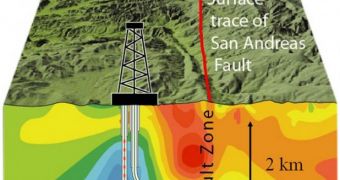A large number of the earthquakes that take place on the San Andreas fault line – one of the most active on the globe – are caused by tidal forces, experts say. These forces are generated by motions in the planet's crust, they explain, which make the tectonic plates on top tremble. The extreme tension is set loose through some designated locations, which also include the West-American fault line. A number of scientists believe that the tides that appear in the Earth's rocks are triggered by the same attraction forces that create similar effects in the oceans, Wired reports.
University of California in Berkeley (UCB) seismologist Amanda Thomas explains that the variation in the rock layer is very tiny, minuscule even, but that sufficiently large forces are generated to cause some minor earthquakes to appear along some fault lines. The new work, which was conducted alongside UCB colleagues Robert M. Nadeau and Roland Burgman, is detailed in the December 24 issue of the esteemed scientific journal Nature.
In the new investigation, the researchers set up shop in the small city of Cholame, California, where more than 1,700 minor earthquakes were recorded between July 2001 and May 2008. The team surveyed a 110-square-kilometer area around the small town, which exhibited the largest concentration of small tremors. The city is located near the southeastern end of a portion of the San Andreas fault line. The main results were that, when tidal forces tended to push the fault along the lines that usually broke it, the intensity of the mini-tremors increased. Conversely, when the tides pushed the fault the other way around, the frequency of the temblors decreased considerably.
Based on these findings, the researchers suggest that the deep portions of the San Andreas fault are very well lubricated. They believe that water may exist between the Pacific and North American plates, and that it is subjected to very high pressures. Additionally, the idea that small changes in the stress levels across the fault line can cause minor earthquakes was further reinforced.

 14 DAY TRIAL //
14 DAY TRIAL //